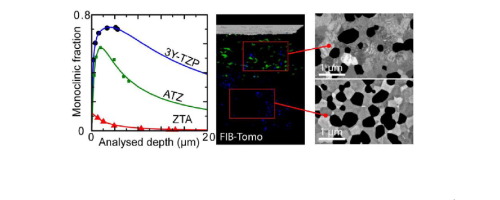Acta Biomaterialia ( IF 9.4 ) Pub Date : 2017-12-21 , DOI: 10.1016/j.actbio.2017.12.021 L. Gremillard , J. Chevalier , L. Martin , T. Douillard , S. Begand , K. Hans , T. Oberbach

|
Zirconia-based materials have been used in orthopaedics since the 1980s, with large success, mainly thanks to transformation toughening. On the other hand, their main drawback is their potential sensitivity to hydrothermal ageing, i.e. tetragonal to monoclinic phase transformation on their surface in the presence of water. Hydrothermal ageing may result in roughness increase and microcracking of the surface. In this article the hydrothermal ageing behaviour of three medical-grade zirconia-based materials is assessed at high temperature and extrapolated to room or body temperature. The degradation is also characterized by FIB/SEM nano-tomography to better assess sub-surface evolutions. In both zirconia and alumina-toughened zirconia (ATZ), ageing results in the presence of a homogenous transformed layer of constant thickness whose growth rate is about 8 times slower in ATZ than in zirconia. Microcracking occurs in the entire transformed layer in zirconia, but was much less relevant in ATZ. Zirconia-toughened alumina (ZTA) is much less prone to ageing. In ZTA ageing results in a thin transformed layer in which the monoclinic fraction decreases with depth. No microcracking was observed in ZTA.
Statement of significance
This article details the microstructural evolution of the surface of three zirconia-based ceramics when exposed to water (hydrothermal ageing), and establishes a time-temperature equivalences of these evolutions. It shows that different zirconia-alumina composites do not degrade the same way: zirconia and alumina-toughened zirconia present a homogeneous degraded zone of constant thickness, whereas zirconia-toughened-alumina presents a gradient of transformation.
These new findings will help understanding better the hydrothermal degradation of zirconia based materials, and in particular will facilitate a better prediction of the durability of zirconia-based devices such as orthopaedic implants and dental devices (implants, crowns, abutments...).
中文翻译:

用于髋关节应用的含氧化锆的股骨头水热老化的亚表面评估
自1980年代以来,基于氧化锆的材料已在整形外科中使用,并取得了巨大成功,这主要归功于相变增韧。另一方面,它们的主要缺点是它们对热液老化的潜在敏感性,即在水的存在下,其表面由四方向单斜相转变。水热老化可能会导致粗糙度增加和表面微裂纹。在本文中,在高温下评估了三种医用级氧化锆基材料的水热老化行为,并将其推断为室温或体温。还通过FIB / SEM纳米断层扫描对降解进行了表征,以更好地评估表面下的演变。在氧化锆和氧化铝增韧氧化锆(ATZ)中,时效都会导致存在厚度恒定的均匀转化层,其ATZ的生长速度比氧化锆慢8倍。微裂纹在氧化锆的整个转化层中发生,但在ATZ中的相关性则小得多。氧化锆增韧氧化铝(ZTA)不易老化。在ZTA中,时效会导致形成薄的转化层,其中单斜率随深度降低。在ZTA中未观察到微裂纹。
重要声明
本文详细介绍了三种氧化锆基陶瓷在暴露于水(水热老化)时表面的微观结构演变,并确定了这些演变的时间-温度等效性。结果表明,不同的氧化锆-氧化铝复合材料不会以相同的方式降解:氧化锆和氧化铝增韧的氧化锆呈现均匀厚度不变的均匀降解区,而氧化锆-增韧氧化铝呈现出梯度变化。
这些新发现将有助于更好地理解基于氧化锆的材料的水热降解,特别是将有助于更好地预测基于氧化锆的设备的耐久性,例如整形外科植入物和牙科设备(植入物,牙冠,基台等)。











































 京公网安备 11010802027423号
京公网安备 11010802027423号